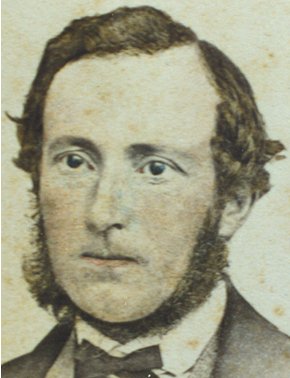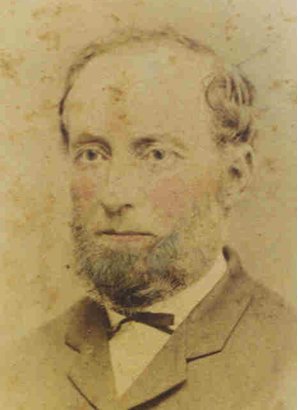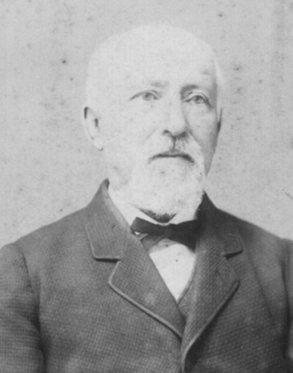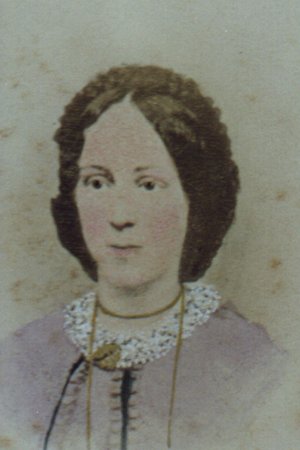Edward Ford Newman 1827 - 1911
| ||||
|
| ||||
|
In the 1851 Census we find that mother and son have moved to 9 Castle Mill Street, Bristol where they are listed as being ironmongers. Perhaps they were not very successful as either innkeepers or ironmongers for by the 12th July 1852 they had bought a ticket on the Velore to go to Australia. What was it that made them decide to go to Australia? Was it the promise of a better life, the lure of gold or what? At the time Edward Ford and his mother were living in Bristol it was a very busy port and the Wheat Sheaf Tavern was only one short block away from the docks. They must have had many sailors frequenting the tavern and possibly guests who were about to emigrate to Australia. Gold had been discovered in Ballarat and Bendigo in Victoria, Australia in 1851. I feel that it is no coincidence that a young, single man of 25 should choose that time to go to Australia although I have never heard any stories of him making his fortune as a gold miner. There were other ways of making a living or even a fortune by selling goods to the gold miners. As an ironmonger he would have plenty of useful knowledge of the tools needed by the miners. In 2003 my cousins Beryl Kings, né Newman (the daughter of my father's brother, Walter) lent me a small, leather covered note book that was kept by Edward Ford from the year 1848 to just before he went to Australia although there is no mention of this proposed journey in the note book. The notes themselves are a mixed collection of facts like some names and addresses, some puzzles, dates of some happenings and some discoveries, a bit of diary, lists of prices, historical dates and facts, statistics like the heights of mountains and long lists of people's names in Bristol, Bath and miscellaneous Names. There was as well as visits to the theatre that he made, visits of relatives (Aunt Spencer and Aunt Sumsion), his mother's 3 day visit to Ridgeway, Devon (her birth place), and some walking he did to Marshfield and Castle Comb. There was also the date they left the Wheatsheaf, Christmas Street (29th October 1850) and the fact that he and his mother were living at 30 Stoke Croft, Bristol on 19th of December 1850. It was very interesting to read the things that he was interested in but very disappointing that he gave no indication of his future plans. Were the lists of people some that he wanted to remember when he left England? I will transcribe all that I can read. The writing is very good but often rather faded. From the book we can get some idea of his interests but no indication at all of why he went to Australia. So was it Edward Ford's idea to emigrate and did his mother just go along to be with her only son? However it was, a ticket for both of them was purchased at the cost of œ26 to travel 'stierage (sic) to the port of Port Philip or Sydney'. Edward Ford was 25 and Mary Ann 51. œ26 was a considerable amount of money to pay in 1852. They set sail on the 'Velore' on 10th August 1852. Lloyd's Register of Shipping have sent me the information that the 'Velore' was a barque (a sailing vessel with three masts, square-rigged on the fore and main masts and fore and aft rigged on the mizzen). It was 402 gross registered tons (tiny in comparison to any ships of today) and was built in Liverpool which was also her port of registry. Her port of destination is given as Liverpool. I have also found an advertisement in the Times Newspaper Supplement on 14th July 1852 with a rather different description for the Velore. It reads thus: "..the beautiful British clipper ship VELORE , a 12 years, 1000 tons burden, built entirely of English oak, with 7« feet height `tween decks; will leave Bristol the end of July. The improved ventilation, commodious fittings, size and arrangements of cabins, superior quality of provisions, and liberal accommodations, has earned for this line a favourable reputation. All the berths are enclosed.." It is unusual to have two ships with the same name but not impossible, as I have found on another occasion. As The Times advertisement states that this Velore was leaving Bristol for Port Phillip and Sydney, Australia at about the time they left I feel that this was more likely the ship that Mary Ann and Edward Ford were travelling on. More often than not ships left port later than the advertised time. From shipping information at the Australian end we find that the 'Velore' did not dock in Melbourne until 22nd January 1853. This means that the voyage took over 19 weeks. It must have been an horrendous journey. (See The voyage to Australia for description of the voyage. Both Mary Ann and Edward Ford Newman did survived the journey but Mary Ann died of a pulmonary infection fifteen months after her arrival in Australia. Perhaps the arduous voyage sapped her health as she was only 53 years old. Edward Ford settled in Melbourne, Victoria. On 24th November 1860 he married Mary Ann Raymond at St Marks Church, Collingwood, Melbourne. On his marriage certificate he is given the occupation of salesman. We will never know if he ever tried his luck on the gold fields either mining himself or selling goods to the miners. I personally feel that the latter is the more likely. Edward Ford and Mary Ann's first child, Edward, my grandfather, was born to them on 15th June 1861 at 17 Hanover Street, Fitzroy which was the home of Mary Ann's parents. They had two other children, Marion Alberta and George Frederick but they both died in infancy. Edward Ford, Mary Ann and their baby Edward lived at 27 Regent Street, Fitzroy. This is only a short street very near to Hanover Street and now has no houses in it at all - only factories. The young Mary Ann Newman, died at at the very early age of 26 years on 11th December 1865. Edward Ford did not marry again until 11 years later in 1886, this time to Emma Jane Thompson. A a ddaughter, Edith, was born from this marriage in 1887. | ||||
My grandfather, little Edward was brought up by his mother's
parents,
Edward Ford predeceased Emma Jane and she inherited his property and became his executrix. He is named as a deceased accountant - a step up from a salesman. The house they lived in and which became part of Edward Ford's legacy to his wife was 59 Turner Street, Abbotsford, Melbourne. Today on one side of this street there is the Collingwood Football Ground; on the other side, where the odd numbers are, all of the original houses are still there except number 59. Number 59 is a bigger block than the other houses and now has a modern house on it. In the documents attached to the will there is a description of the property. It says that it had a frontage of 33 feet and a depth of 132 feet and that the property on it was weather board dwelling house lathed and plastered within, iron roof, and Scullery at back. It adds that the buildings are old and out of repair and that the Municipal Valuation was œ520; that it would let at about 12 shillings per week. There is also a description of another house owned by Edward Ford at 43 Coppin Street, Richmond. This had a frontage of 18 feet and a depth of 108 feet on which was erected a four roomed brick dwelling house with an iron roof plus a bathroom and scullery. This also was not in good repair, was valued at œ400 and was let at 9 shillings and sixpence per week. A house like this is bigger than it appears as it spreads a long way back. This kind of house is now considered a desirable residence in Melbourne and is much in demand. Edward Ford also left furniture (very old) worth œ13, rents worth œ2/18/0, money in hand £3/7/6, deposit in Savings Bank, Collingwood £91/13/5 plus interest of £2/4/0, 200 shares in the Australian Mont de Piete worth £95 and 100 shares in Victorian Permanent Building Society worth £13/15/0. This made altogether £774/17/11. Today (2002) this would be worth approximately £100, 000 had it all been in cash, but the properties themselves would now be worth several hundreds of thousands pounds or dollars. All told it seems that Edward Ford did well out of his emigration to Australia although he was certainly not destitute in England if he could afford the fare out and probably had enough money to set himself up in some sort of business in Australia. Mary Ann Newman, née Raymond 1839 - 1865Mary Ann Newman was my great-grandmother. She was born on 25th September 1839 according to the Raymond family bible although so far I have been unable to find a birth certificate for her. As her birth was not long after birth registration started in England (1837), and people had not quite got used to it, maybe it was missed. From other records it would seem that she may have been born in London. She was not baptised until 13th September 1848 when she was nine years old and she was baptised at Holy Trinity Church, Paddington at the same time as her six year old brother, George. In 1841 the Raymond family were living at 23 Portman Place in London and Mary Ann's father, Thomas, described himself on the census as a "Gent of independent means", so it sounds as if they were reasonably well off. By the census of 1851 Thomas had become a house agent employing a clerk and the family had moved to 1 Bishop Street, Paddington. The house was also being used as an office for the business. In the 1841 and 1851 Censuses and on the shipping list of the "Ralph Waller" on which the family went out to Australia in April 1855 Mary Ann is named as Marian although in the family bible and on her marriage and death certificates she is named Mary Ann. In this account I will continue to call her Mary Ann but in another account of her parents, for the sake of distinguishing her from her mother, I have called her Marian.
The next record we have of the family is of their emigration to Australia on the "Ralph Waller" in 1855. I would love to know why they made this decision. Even thought it was a difficult period in England with much unemployment this hardly seems to have applied to this family as only a year or so earlier Thomas, her father, had described himself as `a Gent of independent means'. So maybe they thought they would do better in Australia. They were certainly able to pay their own fare. Melbourne was a fast growing town and maybe Thomas thought there might be a good opportunities for a house agent or builder. There was also heavy recruitment for settlers of all classes from the Australian end. It is also possible that they went for health reasons. We know that Mary Ann suffered from Tuberculosis. Sea voyages were supposed to be a cure for this disease and a new country was probably considered healthier too. By the time the family emigrated to Australia, Mary Ann would have been fifteen years old and it is possible that she was not able to be accommodated with her parents as only children up to the age of fourteen were kept with their parents. However the accommodation on the "Ralph Waller" it seems to be superior to many other ships at the time. It had three different grades: Cabin, Intermediate and Steerage. From the record in the newspaper when they arrived in Melbourne I do not think that the family were Cabin passengers; it is possible that they may have travelled in the Intermediate section and had better accommodation. If the family had travelled in the Steerage section then, as Mary Ann was older than 14, she would have had to travel in the part of the ship reserved for single women. Somehow I don't think that her parents would have wanted this. I have the impression that Mary Ann was a much favoured daughter. The journey took over 3 months. This voyage in the "Ralph Waller" proved to be extremely dangerous and will be described fully in a later part of this book In Australia Mary Ann's father became a builder and from records in the State Library the family seem to have lived in various addresses in Fitzroy, Melbourne. Six years after her arrival in Melbourne, Mary Ann married Edward Ford Newman. Mary Ann Raymond and Edward Ford Newman were married at St Marks Church, Collingwood on 24th November 1860. Mary Ann was 21 years old and Edward Ford was 33. Their first son, Edward, was born on 15th June 1861. Two more children were born to them, Marion Alberta (born 1863, died 1864) and George Frederick (born 1865, died 1865) so both died in infancy. On 11th December 1865, Mary Ann, who had only just reached the age of 26, died of Tuberculosis (or consumption, as it was called then). On her death certificate it says that the disease was of "long-standing" so she had obviously had it for many years. Her little son, Edward was only four years of age. |




